All pet owners have wondered at one point or another – what is my dog thinking?
Humans rely primarily on language to communicate, so it’s natural that we wish our dogs could talk to us. But dogs already tell us plenty about their emotional state based on their body language.
With that in mind, we’ve collected a variety of examples of various dog body language queues you can use to work on your translation skills. Consider this your dog body language study guide!
We hope this guide helps you better understand your furry pal!
Dogs Don’t Communicate Verbally; They Do It with Body Language
Dogs have different kinds of barks that can indicate a handful of moods (such as an alert bark, excited bark, a territorial bark, etc). However, dogs communicate primarily through body posture and positioning.
Dogs signal their feelings through their:
- General body posture
- Ear position
- Tail position
- Mouth shape
- Facial expression
These queues seem subtle to us humans because we rely on verbal language more than body language to communicate (and the rise of internet use and texting has made body language even less relevant for modern humans).
Many of us find ourselves perplexed by a dog’s response to a situation. Why did he snap like that? It came out of nowhere! But a dog communicating with body language has likely already made it very clear he’s unhappy or nervous about the situation. We just aren’t taking the time to translate!
Our job as dog owners and care providers is to take the time to learn our dog’s language. It’s the polite, responsible thing to do for these creatures that live in our homes. They deserve to be heard and we can exercise our empathy powers by studying the dog body language manual.
Calming Signals
Calming signals are actions and movements dogs used to try to relax themselves. They can be performed when a dog is anxious about a situation and is trying to stay cool, or when a dog is extremely excited and trying to keep himself calm.
Dogs might also use calming signals during dog-on-dog play, signaling that they need a bit of a break from the action.
Context is very important for understanding how to take action when witnessing a calming signal. If your dog is excited to go on a walk and is displaying calming signals, there’s no reason to freak out. Just buckle up and go outside!
If your dog is playing with other dogs and displays calming signals, you could call your dog over to help them take a break. Or – if your dog’s playmates back off – you can leave it at that.
If your dog is being surrounded by children petting him, it might be time to move on and disperse the kiddos.
Your next steps with calming signals might depend on whether or not your dog is also displaying fear indicators, discussed in more detail below.
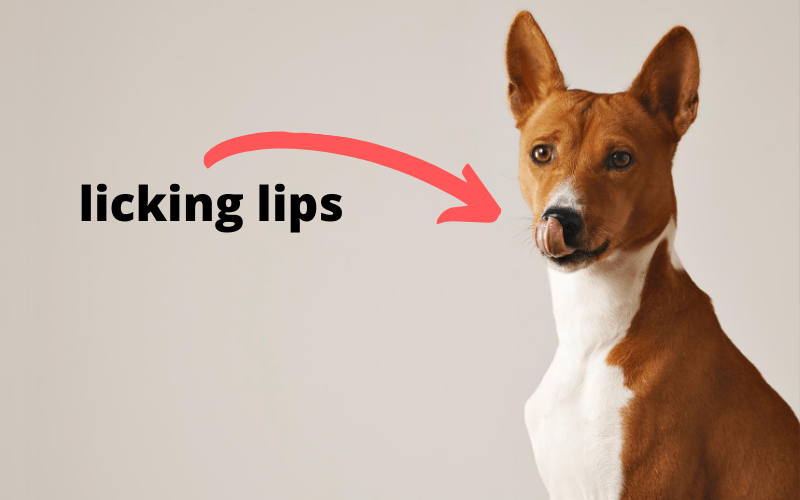
Lip licking is a common but often misinterpreted calming signal.
When I first got my own dog Remy, who is dog reactive, he would often lick his lips walking near other dogs. Initially, I made jokes about this behavior as Remy wanting to eat the smaller dogs, without realizing what Remy was really saying, which was Woah – another dog!! I’m not sure how I should feel about this...
For humans, we often equate lip licking to hunger. While a dog may lick his lips when he’s awaiting a mouth-watering bowl of dog food, a lick lip or tongue flick is more commonly used as a calming signal.
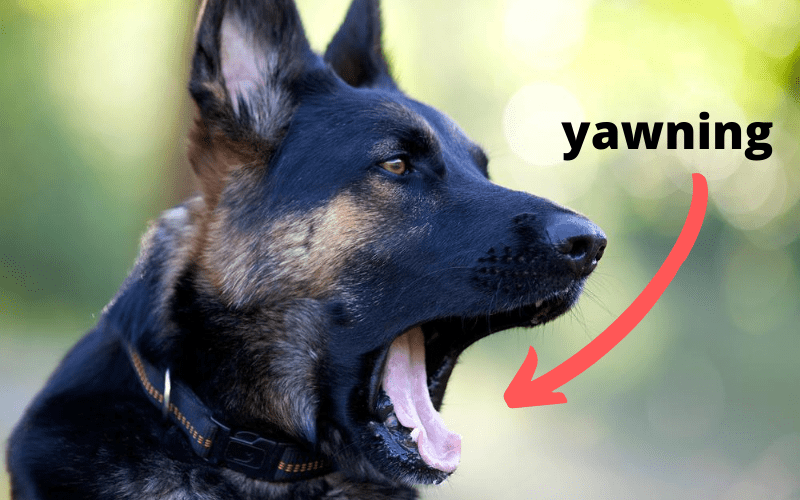
Excessive yawning is another classic stress signal showing your dog may be uncomfortable or anxious. Yawning also acts as a calming signal, which is a behavior your dog uses to calm themselves.
For example, when I tell my dog we are going for a walk, as I gather my treat pouch and put on my shoes, he will often yawn as he tries to control his excitement.
Nervousness has a similar energy as excitement, which is why several behaviors such as yawning can be used to indicate anxiety as well as a tool your dog uses to calm himself.
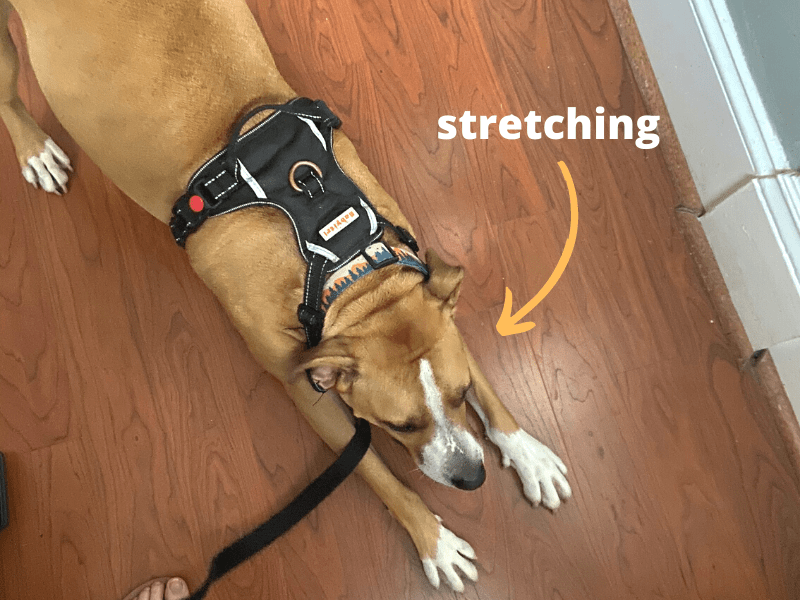
Stretching is a calming signal I see in my own dog all the time. It’s his favorite way of calming himself down. Many times as I go to get his food or get up to grab his leash, he will begin stretching to transfer his excited energy into an acceptable physical action.
I’m sure even humans can appreciate the relaxing sensation that follows a nice big stretch!
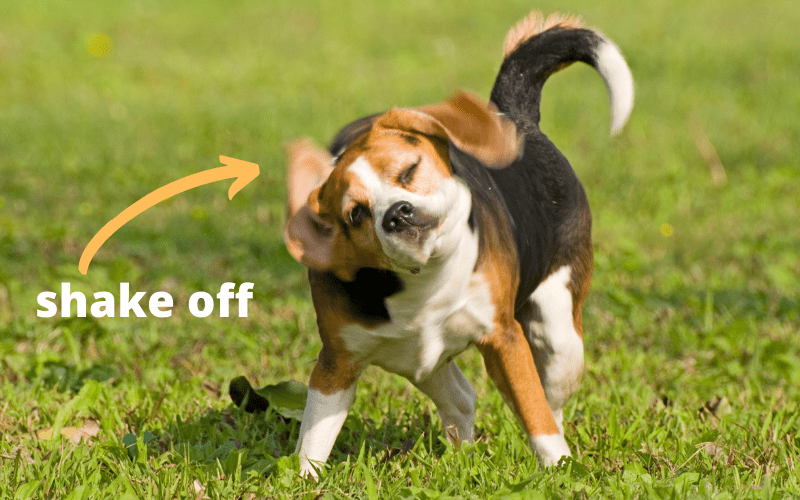
A shake-off is another classic calming signal. Similar to stretching, a dog will often shake to physically release pent up excitement or nervousness.
I’ll often see my dog shake right after I clip on his leash. It’s his way of saying “wow, I’m so excited to go for a walk! Let me just reign in my crazies for a second!”. I’ll also witness my own reactive dog shake himself down after an encounter with another dog, as he tries to self-soothe and calm himself.
If you have a dog who is easily aroused, it’s not a bad idea to reward them for shaking. It’s a great coping mechanism we want to encourage our dogs to use when they are feeling too amped up!
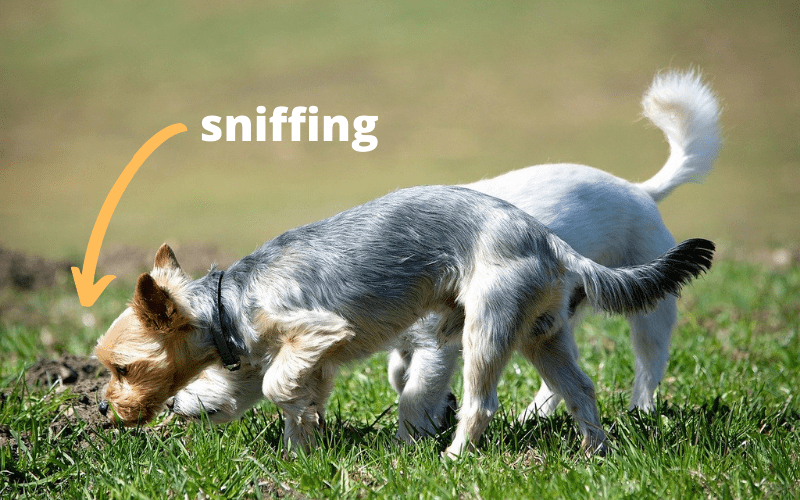
Dogs sniff for a myriad of reasons. Dogs tend to sniff a lot because that is how they interpret the world. A dog’s sense of smell is much more powerful and important for them than their sight.
However, if you witness your dog sniffing in a situation where it doesn’t seem quite right, it could be that your dog is trying to relieve some stress.
Dogs during play will often take a break from romping around and suddenly begin to sniff the grass. This is done to defer and de-escalate.
Think of sniffing in this case a bit like glancing at your phone as you walk down an empty street towards a stranger, or stopping to re-tie your shoe. It’s a way to break up the intensity of an interaction and give yourself a little breather.
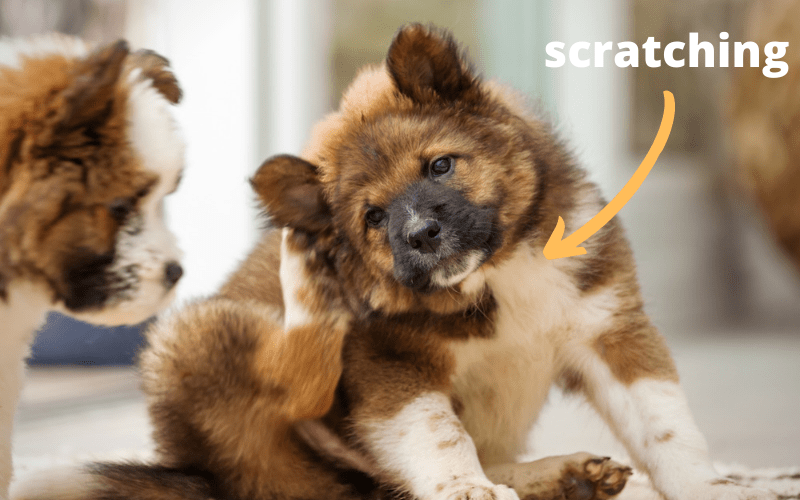
Scratching or itching (when there’s no reason to be itchy) is another calming signal similar to sniffing – it gives your dog something to do other than stare at another pooch.
It’s a great canine tool for breaking up play sessions when your dog needs a break. It’s a bit like when you might retreat to the bathroom at a crowded party for a breather, even if you don’t have to use it!
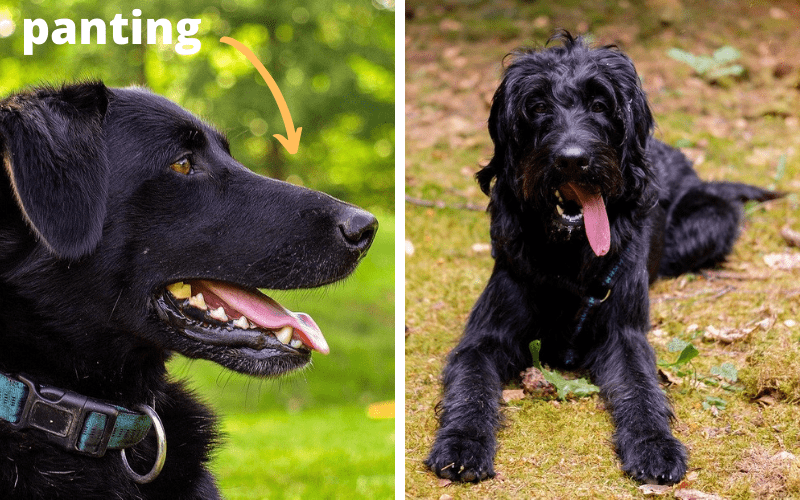
Panting is a stress indicator, but it’s a tricky one because dogs will also just pant to cool themselves off, so it can be tough to know what panting is due to stress and what’s simply due to the heat.
Generally, a long, floppy tongue – as seen in the dog on the right – is usually due to heat rather than a sign of stress.
A more retracted tongue with a lot of rapid panting tends to be more of a stress signal.
Other calming signals that aren’t so easily shown with images include:
- puffing / large sigh
Fear Indicators
While calming signals are physical actions dogs used to calm themselves down when nervous or excited, fear indicators are body language signals that a dog is very uncomfortable or frightened.
You will likely often see fear indicators like whale eyes or a tucked tail in conjunction with calming signals as a dog attempts to self-soothe during a stressful situation.
Remove your dog from the frightening stimulus or situation immediately.
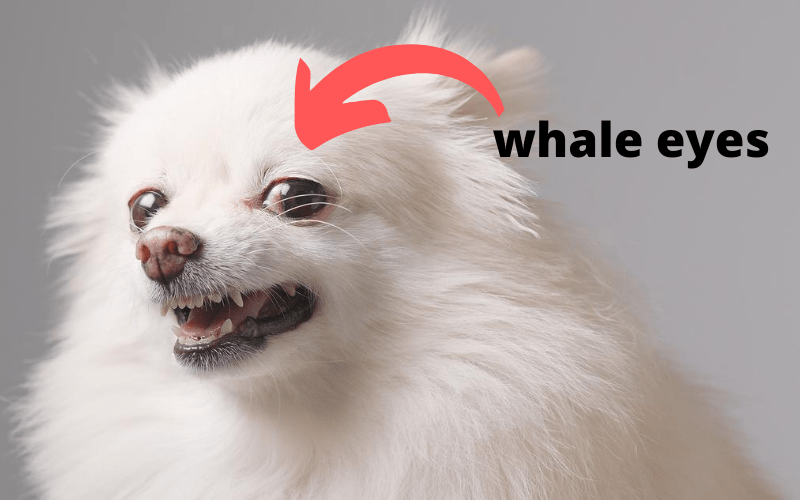
Whale eyes is a classic indicator of fear or nervousness in dogs. Also known as moon eyes due to the crescent shape of the dog’s eye whites (aka the sclera).
Making direct eye contact with another dog is considering an aggressive action, so when dogs avert their gaze as far away from you as possible, you’ll see the whites of their eyes, indicating fear or anxiety as they try to avoid eye contact with you.
It’s worth noting that sometimes you’ll see whale eyes on your dog when they are simply facing you but looking over at something interesting to the side of you. Context is important – if your dog doesn’t seem to be looking at anything interesting or is showing other stress signals, whale eyes is likely sign that your dog is uncomfortable and needs the situation to change ASAP.
Dilated pupils, which can make your dog’s eyes appear ‘glassy’, are another indicator of fear or extreme arousal.

A tucked tail is another classic (and easy to recognize) indicator of fear or nervousness. A tail that’s tucked this far beneath a dog means this pup is really frightened!
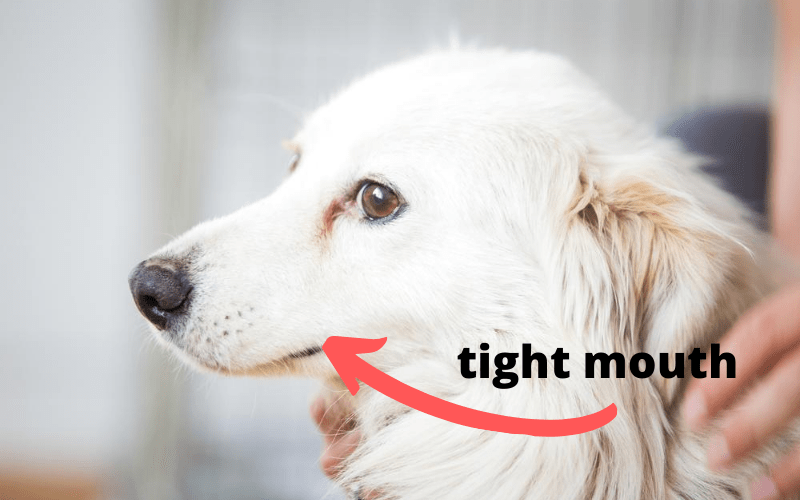
A tightly closed mouth often indicates fear or nervousness in dogs. You may also see a frightened dog pull the corner of his lip back, referred to commonly as “long lip”.

It’s no surprise that showing teeth is an indicator of fear – this dog is likely growling too and might give a snap at any moment as a warning sign to say Hey – back off!
Some dogs will be more subtle with their mouth and just pull their lips back slightly into a curled lip that reveals a bit of teeth.
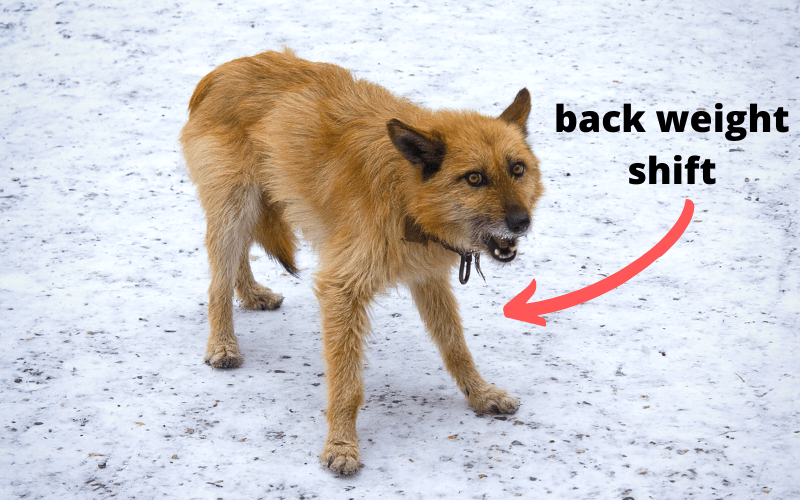
A back weight shift is a pretty clear indicator that a dog is frightened or nervous, as he tries to get as far away from the offending stimulus as possible. The dog in this photo also has a tucked tail.
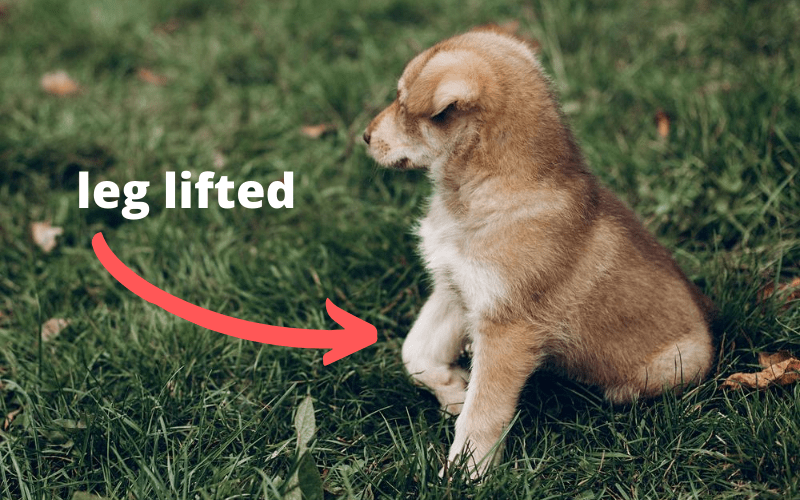
A lifted leg is a common signal of stress, anxiety, or amped up excitement. Again, context is important for evaluating if your dog is just especially excited after smelling the scent of a nearby critter, or nervous about something in the area.
Some breeds (notable hunting breeds) will display leg lifts much more often as tracking indicators, so don’t get too worried if you see your hound dog doing a lot of leg lifts!

When a dog moves away from an individual, it’s a pretty clear sign of asking for some space. Even a subtle weight distribution away from you may be your dog’s polite way of saying “I’d rather be left alone.”
Instead of moving towards the dog and trying to comfort them or insist on proving you’re their friend, be a true friend and respect their wishes for personal space.

Flattened ears can be another sign of fear or anxiety in dogs. A dog’s ears can be extremely expressive – and we’ll talk more about ear posture below. If you’re looking to get a quick gauge on how your dog is feeling, the ears are a great go-to indicator.
Keep in mind that some ears can be more difficult to assess depending on your dog’s breed and specific ear type. For example, dogs with long, floppy ears (like English cocker spaniel or Bloodhounds) can have ear positions that are more difficult to read than dogs with perky, pointy ears that move around a ton.
Still, if you examine the base of even a floppy-eared dog’s ears, you should be able to see them move and rotate based on what’s happening around them.

A tense, wrinkled face is a sign of stress or agitation. While a smooth, relaxed face indicates a calm and happy dog, a wrinkled face says something else.
A lot depends on context for this one. For example, my own dog has resting wrinkle face – he almost always has a furrowed brow, but those lines get even deeper when he is outside on a walk and feeling especially alert.

You’ll see raised hackles on your dog when your dog is fearful – but they can also be due to excited arousal. As is often the case with dog body language it is helpful to consider context and your dog as an individual.
For example, I see raised hackles on my reactive dog often during walks when he sees another dog. For him, this isn’t a fear reaction – it’s extreme arousal. Seeing his hackles go up means it’s time for me to help him stay calm and possibly get more distance between us and the other dog if he is having a hard time listening to me.
You can also see other body posture in this photo that indicates more extreme arousal and alertness rather than fear – such as his high tail, forward-leaning body movement, and his raised leg.

Sweaty paws is a fear indicate that can be difficult to catch, as we may not notice when your dog’s paws are beginning to sweat. Just as humans may get sweaty, clamy hands when they are anxious, the same holds true for anxious dogs!
Not always fear- can also be due to excited arousal.

We all know the classic happy doggo who rolls on his back for tummy rubs, but exposed bellies can also be indicators of fear and extreme submission.
Owners who have mistakenly listen to misguided alpha training methods may think that signs of submission like this are good and show that the dog recognizes you as the “alpha”. However, this isn’t the case! All this behavior demonstrates is an extreme fear of you.
Also look for other body language signals, such as a tucked tail. In this photo, since the dog’s tail is fairly loose and relaxed, there’s a good chance he just wants some scritches.
As with most canine communication cues, context is immensely important.
Other signs of fear not shown as well through photos include:
- Growling
- Snarling
- Pacing
- Whining
- Freeze
- Dilated pupils
- Extreme drooling
- Dandruff and excess shedding
You’ll notice that many of these fear indicators are also considered aggressive body language. This is due to the fact that aggression is almost always rooted in fear – dogs display aggressive behavior when they are frightened!
In truth, labeling a dog as “an aggressive dog” is not very helpful, because what you’re actually dealing with is a fearful or anxious dog who displays aggressive behaviors.
Working With a Fearful Dog
If you have a dog who often displays stress signals, he may be dealing with a lot of anxiety or fear in his life.
Make sure you are training with positive reinforcement methods and work on gaining your dog’s trust by stopping any punishment-based training that uses aversives and refocus on rewarding your dog with treats for being brave!
You may want to also consider contacting an expert force-free trainer in your area locally or – for more serious cases of aggression and extreme fear – a certified behavior consultant.
Play Signals
Play signals are behaviors dogs use to show their play partner that they’re messing around and that any barks or growls they make are just all in good fun!

The play bow is one of the easiest play signals to recognize. If the butt’s in the air, all is fair!
Other play signals difficult to show through images include:
- Taking turns (for who is on the bottom or top)
- Self handicapping (dogs who let themselves “lose” to be fair)
- Staying loose and wiggly
- Lots of movement punctuated by brief pauses
- Bouncing paws off the ground
Relaxed Signals
These are easy indicators that your dog is happy and relaxed. All is well in the world for these doggos!

Those squinty eyes are an easy-to-recognize indicator of a happy and relaxed dog. Many dogs will gaze at their pet parents with these soft eyes as a way of expressing trust and adoration.

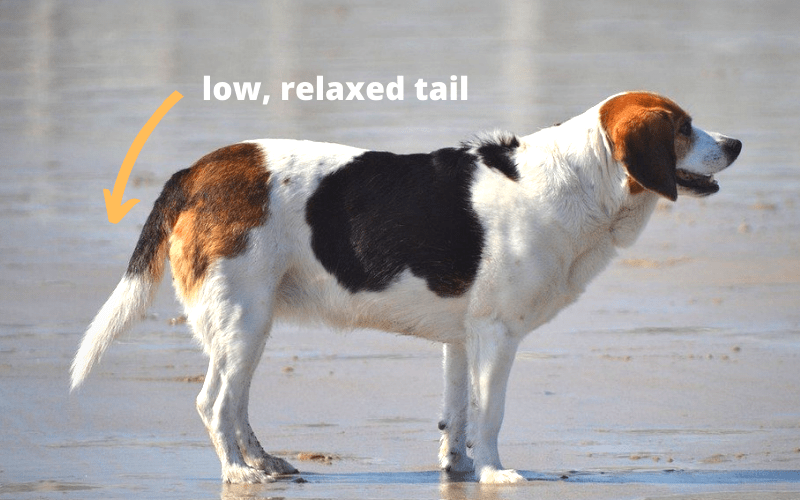
Alert Signals
These are body language cues showing a dog is on alert. A lot of these cues overlap with stress or fear signals since excitement and nervousness share similar energies.


Note this St. Bernard’s stiff body and frozen upright posture. This guy is definitely on edge!
Always exercise caution with an alert dog – do not approach unless you must, as alert behavior can escalate into aggression or de-escalate depending on the dog.
Specific Body Language Indicators: Where to Look
Let’s delve further into specific parts of your dog’s body that you can watch to get a sense of your dog’s mood and feelings.
Tail Wagging: It’s Not Just For Happiness
Most of us as children are told that when a dog wags his tail, it means he is friendly.
If only it were that simple!
Wagging tails can mean a lot of things depending on tail position and speed.
- Low-Hung Tail. Even wagging tails – if unusually low – can indicate fear or uncertainty. Dogs might also rapidly wag a low-hung tail out of appeasement due to fear.
- High, Stiff Wag. A high, rigid wagging tail can indicate agitation or nervousness, but where some dogs may be submissive when afraid, these high waggers may resort to aggression to fend off the scary thing.
- Loose Wag. A middle-of-the-road height in a neutral position with a slow, loose wag indicates a calm, friendly dog. Tail will usually move in a slow swishing or circular motion.
Generally, the faster the tail wag, the more excited the dog is. This can be good or bad depending on the situation – as mentioned earlier, excitement and aggression share a similar ‘amped up’ energy where a dog may begin to lose self-control and resort to jumping up, mouthing, or biting.
We’ve said it before but we’ll say it again – the best way to assess a dog’s state of mind is to examine several body language cues and context. You simply can’t go on the tail alone!
The same hold true for dogs rolling on their backs – some may collapse onto their backs to show they are not a threat because they are terrified. A back roll, combined with a tight mouth and a tucked tail, indicates fear. That dog should not be approached.
A dog who rolls onto his back with an open mouth, a slow wagging tail, and a loose body posture is probably just looking for some belly rubs!
Ear Placement & Positioning
Ears are another helpful tool for assessing a dog’s mood. It’s much easier to notice a dog’s ear movement and positioning when the dogs have high, pointed ears.
Dogs with long, weighted ears (like basset hounds or bloodhounds) are a bit more difficult to read since they aren’t able to move their ears in such a pronounced manner.
However, you can still assess based on the position of the ear base and the direction the ear moves.
- Forward. Alert and curious, possibly agitated.
- Back. Nervous, unsure, or scared.
- Soft and relaxed to the side. Happy and content.
General Body Posture
Let’s take a look at some examples of different dogs in various states.

The dog above has just seen something startling that they aren’t so sure of, hence the cowering lowered body position with low shoulders, tucked back ears, and a tense mouth that seems to be the start of a snarl. While we can’t see his tail, I wouldn’t be surprised if it was tucked down beneath his body.
Even in a still image, it’s easy to tell this dog is frozen, considering his next move.

This is a dog that’s on high alert – he’s probably just about to bark at whoever or whatever is in the distance. His perked-up ears, high tail, closed mouth, and forward body posture all indicate he is excited and alert. His entire body looks tense!
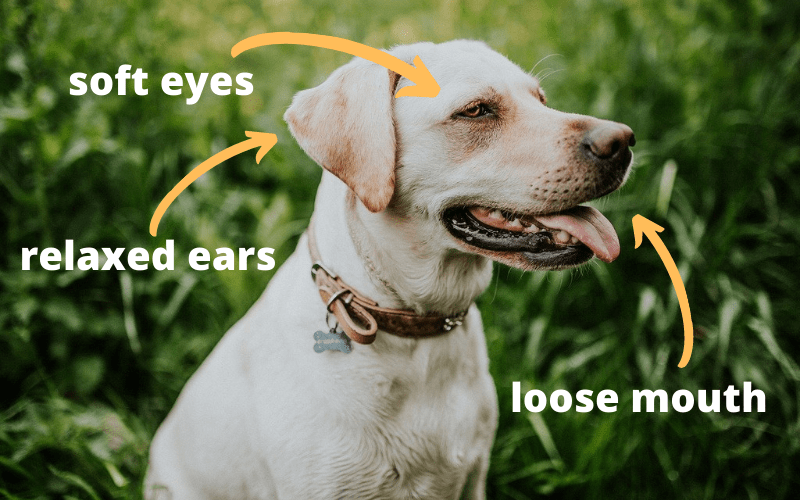
This doggo is feeling happy and shows a relaxed demeanor. Note his soft, rounded, almond-shaped eyes and the loose ears that rest to the side of his head, along with his relaxed mouth.
What About Barks?
Because we humans communicate largely through vocal language, we often assume dogs do the same.
While dogs do provide some limited communication through the sounds they make, between barks, whines, and other vocalizations, body cues tend to be much more indicative of a dog’s emotional state.
However, dogs do have different types of bark variations that can vary in tone and intensity depending on the situation. For example, your dog’s alert bark may sound very different than an excited bark, or a bark your dog emits to tell you he wants to come in from outside.
My Dog’s Body Language
Let’s take a look at my dog Remy and see what the changes in his body posture might indicate.
In the photo below, you can see what Remy’s relaxed tail vs his alert tail looks like. Remy’s relaxed tail goes straight out parallel to his body, or may droop slightly down.
When Remy is on alert, his tail perks up and sits high. In the photo below, Remy sees another dog right as his tail goes up.

In the next photo, Remy goes from relaxing at the park to a slightly more alert look as he sees a dog across the field. Note how his mouth closes tightly.
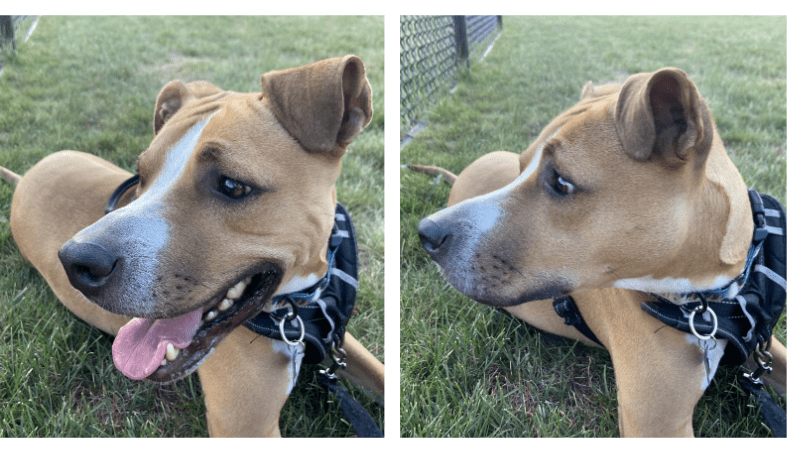
Remy is very easily overly aroused, which means he can get very excited very quickly. Many excited dogs will simply jump up and down a bit and run in circles.
But for some dogs like Remy, excitement and arousal can easily cross over into aggressive behaviors like mouthy grabbing, biting, and barking.
Observing Remy’s body language helps me assess his level of arousal. If I see him getting overly aroused, I can redirect his attention to a toy or get him refocused by asking for some basic commands.
Dog Body Language Quiz
Dogs will show plenty of indicators that they are happy with you and enjoy your company. Some signals are obvious, such as a wagging tail or immense excitement when you return home from being away.
Other signals are more subtle. Some dogs show they care simply by wanting to be next to you or lay down in the same room that you’re in. Some dogs like to lean against their favorite people. Others will try to get in your lap and lick you!
You can interpret and recognize a dog’s body language by paying careful attention to:
– Ear positioning (flat, far back ears indicate uncertainty or feat)
– Body posture
– Eyes (looking away with whites of the eyes showing indicates fear)
– Mouth positioning (tightly closed long mouth indicates displeasure or fear, relaxed open mouth indicates calmness)
– Facial features (furrowed brow indicates arousal, relaxed face indicates calm)
– Tail (Level, slow tail wag indicates calm happiness, high tail indicates arousal or excitement, low tucked tail indicates fear)
Ultimately though, there is no one part of the body you should look at – instead, take into consideration all the canine communication cues your dog is offering as well as the context of the situation.
You can show your dog you love him by gently petting him, playing with him, cuddling with him (if he likes to cuddle), and scratching him in his favorite spots (like behind the ears or his booty).
Dogs do not usually like to be hugged or kissed, as this is strange behavior to them and can even be frightening.
A sad, depressed dog is generally apathetic about things he is normally excited about. Indicators that your dog is sad or depressed may include – lacking interest in food, walks, and play.
Have you learned to read your canine’s body cues? What do you notice about your own dog’s body language cues? Share your thoughts in the comments!